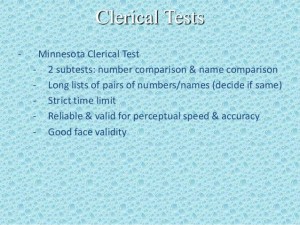The Minnesota Clerical Test (MCT) first was published under the title of the Minnesota Vocational Test for Clerical Workers in 1933 for use in the selection of clerical personnel and to provide career guidance information. The instrument has remained unchanged since its first publication.
The MCT is a brief test, taking 15 minutes to complete. The test itself comprises two parts that measure numerical and verbal acuity. These skills are assessed by asking respondents to identify identical pairs of numbers or words. The two sections, Numerical Comparison and Name Comparison, yield separate scores calculated by adding up the number of correctly identified same pairs minus any pairs incorrectly marked as similar or similar pairs that are not marked. For each section, the maximum raw score possible is 200.
 The most recent MCT manual, published in 1979, provides updated information on the instrument’s reliability and validity. Information on the test-retest reliability of the MCT is provided on a sample of female business school students at both a northeastern university and a midwestern university. The test-retest reliability of the Numerical Comparison section, with four days between test sessions, was .81 for the northeastern sample and .83 for the midwestern sample. For the Name Comparison section, the test-retest reliability was .86 and .87 for the northwestern and midwestern samples, respectively. Evidence of reliability for the MCT also shows stability in scores over long periods of time. The manual provides data on bank bookkeeping machine operators and two samples of clerks, who were retested during a span of 8 to 54 months. Correlations between the first and second testing ranged from .56 to .69 for Numerical Comparison and .62 to .81 for Name Comparison.
The most recent MCT manual, published in 1979, provides updated information on the instrument’s reliability and validity. Information on the test-retest reliability of the MCT is provided on a sample of female business school students at both a northeastern university and a midwestern university. The test-retest reliability of the Numerical Comparison section, with four days between test sessions, was .81 for the northeastern sample and .83 for the midwestern sample. For the Name Comparison section, the test-retest reliability was .86 and .87 for the northwestern and midwestern samples, respectively. Evidence of reliability for the MCT also shows stability in scores over long periods of time. The manual provides data on bank bookkeeping machine operators and two samples of clerks, who were retested during a span of 8 to 54 months. Correlations between the first and second testing ranged from .56 to .69 for Numerical Comparison and .62 to .81 for Name Comparison.
The two parts of the MCT have been shown to be highly correlated. For male and female samples of mixed ethnicity, correlations between the Numerical and Name sections ranged from .58 to .73. The samples included students, job applicants for clerical positions, and experienced clerical workers.
Data supporting the validity of the MCT also are provided in the manual. For example, scores on the MCT for samples of employed clerks and secretarial and business students were correlated with a variety of other clerical tests for verbal and numerical ability. Correlations between verbal tests and the MCT Name section ranged from .36 to .52. Correlations ranged from .38 to .59 between numerical tests and the MCT Numerical section.
The MCT has been used in research and selection procedures. For example, reports have been published using the MCT as a predictor of job performance and clerical task performance. The MCT also has been used in employee selection. Last, research on the MCT has focused on creating norm comparison groups, and research also has focused on practice effects.
See also:
References:
- Andrew, D. M., Paterson, D. G. and Longstaff, H. P. 1979. Manual for the Minnesota Clerical Test. San Antonio, TX: The Psychological Corporation.
- Hall, W. B. and Gough, H. G. 1977. “Selecting Statistical Clerks with the Minnesota Clerical Test.” Journal of Psychology 96:297-301.
- Silver, E. M. and Bennett, C. 1987. “Modification of the Minnesota Clerical Test to Predict Performance on Video Display Terminals.” Journal of Applied Psychology 72:153-155.
